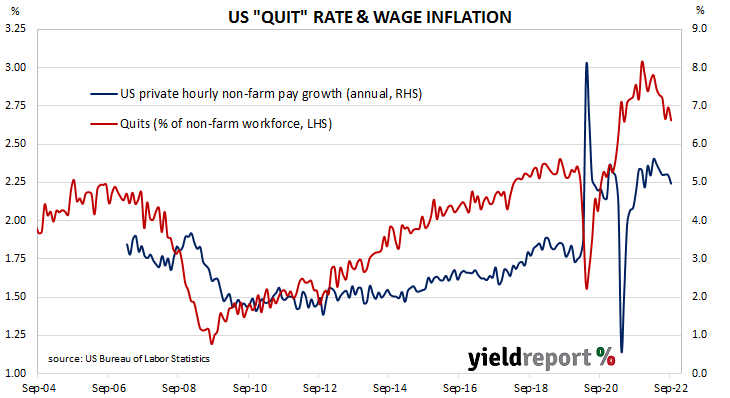Summary: US quit rate steady at 2.7% in September; report a “frustrating outcome” for Fed; US short-term yields up, longer-term yields down; expectations of higher rates harden; quits, separations down, openings up.
The number of US employees who quit their jobs as a percentage of total employment increased slowly but steadily after the GFC. It peaked in March 2019 and then tracked sideways until virus containment measures were introduced in March 2020. The quit rate then plummeted as alternative employment opportunities rapidly dried up. Following the easing of US pandemic restrictions, it proceeded to recover back to its pre-pandemic rate in the third quarter of 2020 and trended higher through 2021 before easing in the first half of 2022.
Figures released as part of the most recent Job Openings and Labor Turnover Survey (JOLTS) report show the quit rate remained steady in September. 2.7% of the non-farm workforce left their jobs voluntarily, unchanged from August, even as quits fell by 123,000 and an additional 263,000 people were employed in non-farm sectors.
“The report is a frustrating outcome for the Fed, which had been hoping the increase in the funds rate so far would take some pressure off the labour market and wages,” said NAB Currency Strategist Rodrigo Catril. “The lack of softening in the JOLTS report alongside a still resilient ISM manufacturing, suggest the Fed still has a fair bit work to do in order to bring inflation to heal.”
Short-term US Treasury yields finished the day noticeably higher while longer term yields fell. By the close of business, the 2-year Treasury bond yield had gained 7bps to 4.55%, the 10-year yield had slipped 1bp to 4.04% while the 30-year yield finished 11bps lower at 4.09%.
In terms of US Fed policy, expectations of higher federal funds rates over the next 12 months hardened. At the close of business, November contracts implied an effective federal funds rate of 3.785%, 71bps higher than the current spot rate while December contracts implied a rate of 4.17%. November 2023 futures contracts implied 4.755%, 168bps above the spot rate.
The decline in total quits was led by 62,000 fewer resignations in the “Accommodation and food services” sector while the “Professional and business services” sector experienced the largest gain, increasing by 58,000. Overall, the total number of quits for the month fell from August’s revised figure of 4.184 million to 4.061 million.
Total vacancies at the end of September increased by 0.437 million, or 4.3%, from August’s revised figure of 10.280 million to 10.717 million. The rise was driven by a 215,000 increase in the “Accommodation and food services” sector as well as sizable increases in the “Health care and social assistance” and “Transportation, warehousing, and utilities” sectors while the “Wholesale trade” sector experienced the single largest decrease, falling by 104,000. Overall, 13 out of 18 sectors experienced more job openings than in the previous month.
NAB Head of FX Strategy, Ray Attrill, described the fall as ”the first meaningful sign of some cracks in the labour market.” However, he also said “the absolute levels are still consistent with a very tight labour market…” He noted “the Fed will undoubtedly welcome the tentative signs of easing demand for labour.”
Total separations decreased by 370,000, or 6.1%, from August’s revised figure of 6.058 million to 5.688 million. The fall was led by the “Accommodation and food services” sector where there were 103,000 fewer separations than in August. Separations decreased in 14 out of 18 sectors.
The “quit” rate time series produced by the JOLTS report is a leading indicator of US hourly pay. As wages account for around 55% of a product’s or service’s price in the US, wage inflation and overall inflation rates tend to be closely related. Former Federal Reserve chief and current Treasury Secretary Janet Yellen was known to pay close attention to it.


